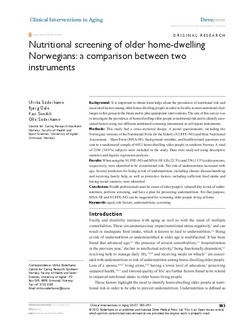| dc.contributor.author | Söderhamn, Ulrika | |
| dc.contributor.author | Dale, Bjørg | |
| dc.contributor.author | Sundsli, Kari | |
| dc.contributor.author | Söderhamn, Olle | |
| dc.date.accessioned | 2012-10-31T13:43:06Z | |
| dc.date.available | 2012-10-31T13:43:06Z | |
| dc.date.issued | 2012 | |
| dc.identifier.citation | Söderhamn, U., Dale, B., Sundsli, K., & Söderhamn, O. (2012). Nutritional screening of older home-dwelling Norwegians: a comparison between two instruments. Clinical Interventions In Aging, 7, 383-391. doi: 10.2147/CIA.S35986 | no_NO |
| dc.identifier.issn | 1178-1998 | |
| dc.identifier.uri | http://hdl.handle.net/11250/138694 | |
| dc.description | Published version of an article from the journal: Clinical Interventions In Aging. Also available from Dove Press: http://dx.doi.org/10.2147/CIA.S35986 | no_NO |
| dc.description.abstract | Background: It is important to obtain knowledge about the prevalence of nutritional risk and
associated factors among older home-dwelling people in order to be able to meet nutritional chal-
lenges in this group in the future and to plan appropriate interventions. The aim of this survey was
to investigate the prevalence of home-dwelling older people at nutritional risk and to identify asso-
ciated factors using two different nutritional screening instruments as self-report instruments.
Methods: This study had a cross-sectional design. A postal questionnaire, including the
Norwegian versions of the Nutritional Form for the Elderly (NUFFE-NO) and Mini Nutritional
Assessment – Short Form (MNA-SF), background variables, and health-related questions was
sent to a randomized sample of 6033 home-dwelling older people in southern Norway. A total
of 2106 (34.9%) subjects were included in the study. Data were analyzed using descriptive
statistics and logistic regression analyses.
Results: When using the NUFFE-NO and MNA-SF, 426 (22.3%) and 258 (13.5%) older persons,
respectively, were identified to be at nutritional risk. The risk of undernutrition increased with
age. Several predictors for being at risk of undernutrition, including chronic disease/handicap
and receiving family help, as well as protective factors, including sufficient food intake and
having social contacts, were identified.
Conclusion: Health professionals must be aware of older people’s vulnerability to risk of under-
nutrition, perform screening, and have a plan for preventing undernutrition. For that purpose,
MNA-SF and NUFFE-NO can be suggested for screening older people living at home.
Keywords: aged, risk factors, undernutrition, screening | no_NO |
| dc.language.iso | eng | no_NO |
| dc.publisher | Dove Press | no_NO |
| dc.title | Nutritional screening of older home-dwelling Norwegians: a comparison between two instruments | no_NO |
| dc.type | Journal article | no_NO |
| dc.type | Peer reviewed | no_NO |
| dc.subject.nsi | VDP::Medical disciplines: 700::Health sciences: 800::Nursing science: 808 | no_NO |
| dc.subject.nsi | VDP::Medical disciplines: 700::Clinical medical disciplines: 750::Geriatrics: 778 | no_NO |
| dc.source.pagenumber | 383-391 | no_NO |
| dc.source.volume | 7 | no_NO |
| dc.source.journal | Clinical Interventions In Aging | no_NO |
